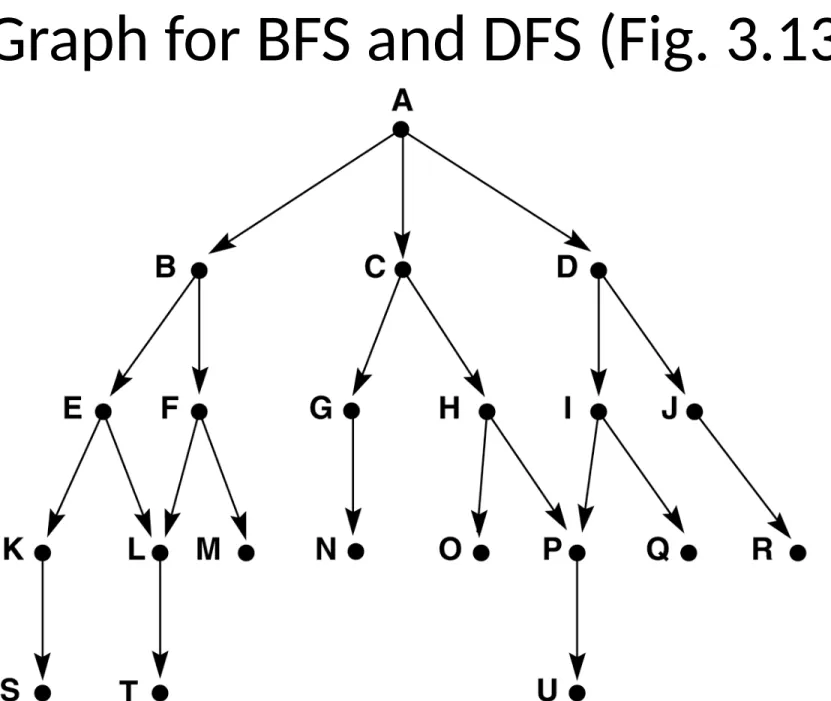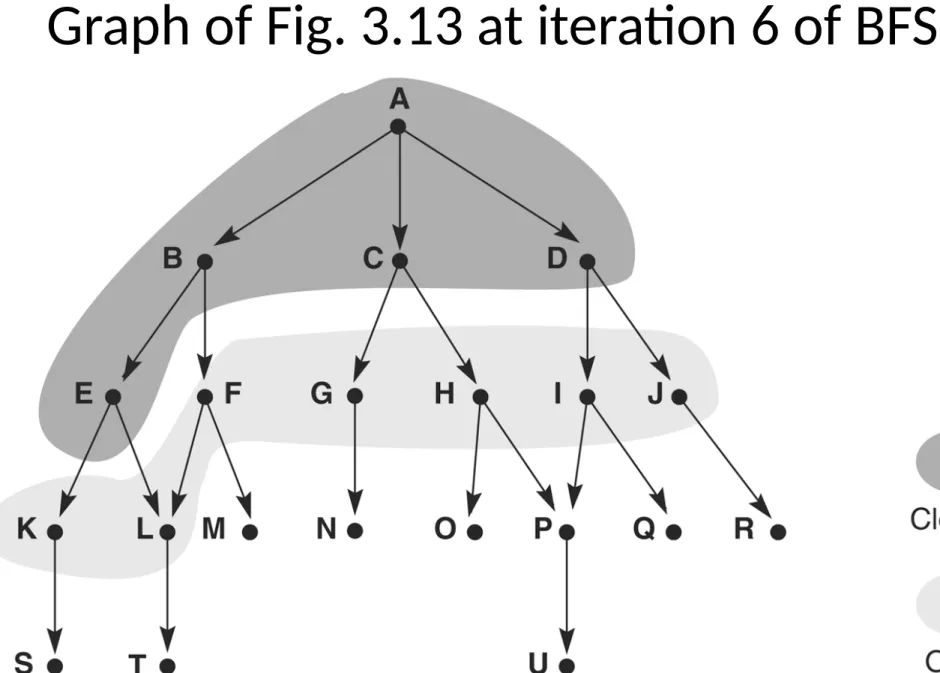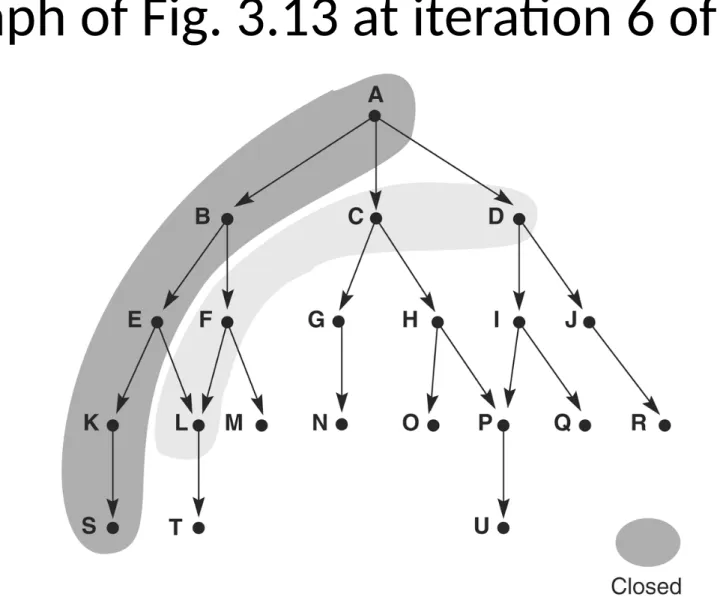Algoritma Pencarian Blind
Breadth First Search Depth First Search
Deskripsi
• Merupakan algoritma untuk mencari kemungkinan penyelesaian
• Sering dijumpai oleh peneliti di bidang AI
Mendefinisikan permasalahan
• Mendefinisikan suatu state (ruang keadaan)
• Menerapkan satu atau lebih state awal
• Menetapkan satu atau lebih state tujuan
• Menetapkan rules (kumpulan aturan)
A unifying view (Newell and Simon)
• Ruang masalah terdiri dari:
• state space adalah himpunan state yang mungkin dari suatu permasalahan
• Himpunan operators digunakan untuk berpindah dari satu state ke state yang lain.
• Ruang masalah dapat digambarkan dengan graph, himpunan state dinyatakan dengan node dan link (arcs) menyatakan operator.
Contoh 1
Seorang petani ingin memindah dirinya sendiri, seekor serigala, seekor angsa gemuk, dan seikat padi yang
berisi menyeberangi sungai. Sayangnya, perahunya sangat terbatas; dia hanya dapat membawa satu
objek dalam satu penyeberangan. Dan lagi, dia tidak bisa meninggalkan serigala dan angsa dalam satu
tempat, karena serigala akan memangsa angsa.
Demikian pula dia tidak bisa meninggalkan angsa dengan padi dalam satu tempat.
State (ruang keadaan)
• State (Serigala, Angsa, Padi, Petani)
• Daerah asal ketika hanya ada serigala dan padi, dapat direpresentasikan dengan state (1, 0, 1, 0), sedangkan daerah tujuan adalah (0, 1, 0, 1)
State awal dan tujuan
• State awal
– Daerah asal (1, 1, 1, 1) – Darah tujuan (0, 0, 0, 0)
• State tujuan
– Daerah asal (0, 0, 0, 0) – Darah tujuan (1, 1, 1, 1)
Rules
Aturan ke Rule
1 Angsa menyeberang bersama petani 2 Padi menyeberang bersama petani
3 Serigala menyeberang bersama petani 4 Angsa kembali bersama petani
5 Padi kembali bersama petani
6 Serigala kembali bersama petani 7 Petani kembali
Contoh solusi
Daerah asal (S, A, Pd, Pt)
Daerah tujuan (S, A, Pd, Pt)
Rule yang dipakai (1, 1, 1, 1) (0, 0, 0, 0) 1 (1, 0, 1, 0) (0, 1, 0, 1) 7 (1, 0, 1, 1) (0, 1, 0, 0) 3 (0, 0, 1, 0) (1, 1, 0, 1) 4 (0, 1, 1, 1) (1, 0, 0, 0) 2 (0, 1, 0, 0) (1, 0, 1, 1) 7 (0, 1, 0, 1) (1, 0, 1, 0) 1 (0, 0, 0, 0) (1, 1, 1, 1) solusi
F W D C
W D C F
D C F W
W C F D
W D
F C
F W C D
F W D C
W F D C
F W C D W C
F D
C F W D
F C
W D
F D C W
D F W C
F W D C F W
D C
F W C D
W D
F C
W F D C C
F W D D C
F W
D F W C
F D C W F W D
C F D
W C
F W D C D
F W C
Goal State
Repeated State
Illegal State
Search Tree for “Farmer, Wolf, Duck, Corn”
Last time we saw
Contoh 2 – Eight Puzzle
1 4 3
7 6
5 8 2
1 4 3
7 6 2
5 8
State space of the 8-puzzle generated by
“move blank” operations
The 8-puzzle problem as state space search
• State : posisi board yang legal
• Operator : up, left, down, right
• Initial state (state awal) : posisi board yang telah ditentukan
• Goal state (state akhir) : posisi board yang telah ditentukan
Catatan :
Yang ditekankan disini bukan solusi dari 8-puzzle, tapi lintasan/path dari state awal ke state tujuan.
State space of the 8-puzzle (repeated)
Contoh 3
Traveling Salesperson Problem
Traveling salesperson problem as state space search
• The salesperson has n cities to visit and must then return home. Find the shortest path to travel.
• state space:
• operators:
• initial state:
• goal state:
Search of the traveling salesperson problem.
(arc label = cost from root)
Nearest neighbor path
Nearest neighbor path = AEDBCA (550) Minimal cost path = ABCDEA (375)
Breadth-First Search
Search
DEPTH 0 (d=0) DEPTH 1 (d=1)
DEPTH 2 (d=2)
Breadth_first search algorithm
Search strategies - BFS
BreadthFirstSearch(state space =<S,P,I,G,W>) Open {I}
Closed
while Open do
x DeQueue(Open)
if Goal(x, ) then return x Insert(x,Closed)
for y Child(x ,) do
if yClosed and yOpen then EnQueue(y,Open)
return fail
Open is implemented as queue (FIFO); Closed can be an arbitrary data structure for sets
Breath-first search
S
A D
B D A E
C E E B B F
D F B F C E A C G
G C G F
14
19 19 17
17 15 15 13
G 25 11
Breadth-first search
Breadth-first search
Breadth-first search
Breadth-first search
Graph for BFS and DFS (Fig. 3.13)
Trace of BFS on the graph of Fig. 3.13
Graph of Fig. 3.13 at iteration 6 of BFS
Depth-First Search
Depth_first_search algorithm
Search strategies - DFS
DepthFirstSearch(state space =<S,P,I,G,W>) Open {I}
Closed
while Open do x Pop(Open)
if Goal(x, ) then return x Insert(x,Closed)
for y Child(x ,) do
if yClosed and yOpen then Push(y,Open)
return fail
Open is implemented as stack (LIFO); Closed can be an arbitrary data structure for sets
Depth-first search
S
A D
B D A E
C E E B B F
D F B F C E A C G
G C G F
14
19 19 17
17 15 15 13
G 25 11
Depth-first search
Depth-first search
Depth-first search
Depth-first search
Graph for BFS and DFS (Fig. 3.13)
Trace of DFS on the graph of Fig. 3.13
Graph of Fig. 3.13 at iteration 6 of DFS
BFS, label = order state was removed from
OPEN
DFS with a depth bound of 5, label = order
state was removed from OPEN
“Blind search”
• BFS dan DFS disebut “Blind search” dalam arti bahwa metode ini tidak memiliki pengetahuan tentang masalah sama sekali selain ruang
permasalahan
• Metode BFS dan DFS disebut juga brute-force search, uninformed search, atau weak method
• Dengan metode ini tidak dapat berharap terlalu banyak, tapi metode ini memberikan:
- Worst-case scenarios
- dasar dari algoritma berikutnya
14 Jan 2004 CS 3243 - Blind Search 44
Search strategies
• A search strategy is defined by picking the order of node expansion
• Strategies are evaluated along the following dimensions:
– completeness: does it always find a solution if one exists?
– time complexity: number of nodes generated
– space complexity: maximum number of nodes in memory – optimality: does it always find a least-cost solution?
• Time and space complexity are measured in terms of
– b: maximum branching factor of the search tree – d is the depth of the solution
– m is the maximum depth of the tree
Properties of BFS dan DFS
• Completeness: (Does it always find a solution?)
• Time complexity: (How long does it take?)
• Space complexity: (How much memory does it take?)
• Optimality: (Does it always insure the “best”)
Properties of breadth-first search
• Completeness: Yes, if b is finite
• Time complexity: O(b d), i.e., exponential in d (Rem: b is no. of branches)
• Space complexity: O(b d), keeps every node in memory
• Optimality: Yes, if cost = 1 per step; not optimal in general
• where b is the branching factor, d is the depth of the solution
Kelebihan BFS
• Tidak akan menemui jalan buntu
• Jika ada satu solusi, maka BFS akan
menemukannya. Dan jika ada lebih dari satu solusi, maka solusi minimum akan ditemukan.
Kelemahan BFS
• Membutuhkan memori yang cukup banyak, karena menyimpan semua node dalam satu pohon.
• Membutuhkan waktu yang cukup lama, karena akan menguji n level untuk
mendapatkan solusi pada level ke-(n+1)
Properties of depth-first search
• Completeness: No, fails in infinite state-space
• Time complexity: O(b m)
terrible if m is much larger than d
but if solutions are dense, may be much faster than breadth-first
• Space complexity: O(bm )
• Optimality: No
where b is the branching factor, m is the maximum depth of the tree
Kelebihan DFS
• Membutuhkan memori yang relatif kecil,
karena hanya node-node pada lintasan yang aktif saja yang disimpan.
• Secara kebetulan, metode DFS akan
menemukan solusi tanpa harus menguji lebih banyak lagi dalam ruang keadaan.
Kelemahan DFS
• Memungkinkan tidak ditemukan tujuan yang diharapkan
• Hanya akan mendapatkan 1 solusi pada setiap pencarian



